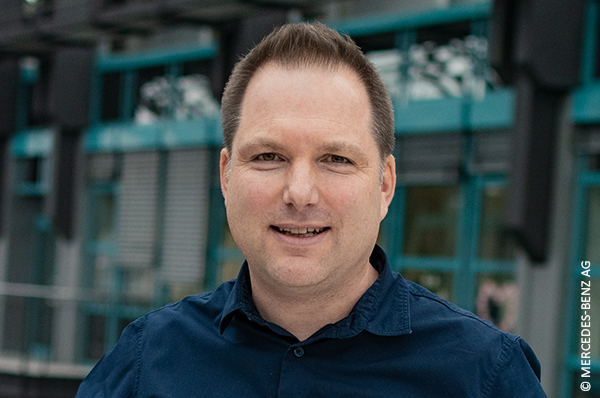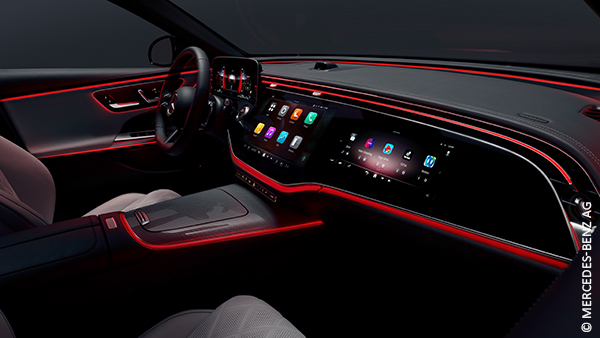
|
We need partners with a fundamental understanding of AIAn Interview with Ralf Rentschler Electrics/electronics (E/E) and software are of key importance for the vehicle development process today. In an interview with the PROSTEP newsletter, Ralf Rentschler explains how software can be deployed in vehicles faster and what role AI plays when it comes to speeding up development. Ralf Rentschler is team leader of IT System Integration, E/E Documentation and Validation at Mercedes-Benz AG. 
Question: What changes are megatrends like electrification and autonomous driving bringing about in the context of E/E and software development at Mercedes-Benz? Rentschler: I'm an expert in E/E hardware and software documentation, so I can't really comment on topics like autonomous driving. However, I am currently experiencing major changes in the methodology used for vehicle documentation. In the past, the pace at which documentation was created was based on hardware development. A few years ago, we decided to separate documentation and software processing from the hardware with the aim of deploying customer-specific features and updates in the vehicles more quickly. And we started to develop and document the software in an agile manner. Question: What challenges does separating E/E hardware and software pose in terms of processes and the IT system landscape? Rentschler: Today, we have a rather heterogeneous IT system landscape in product documentation that has evolved over time. It is constantly being further developed. Different requirements resulting from the timing of software and E/E hardware development, in particular, need be taken into account. We also take this into account when developing new customized documentation systems. Question: Does this separation mean that new coordination points for synchronizing E/E hardware development and agile software development are needed? Rentschler: We have a large end-to-end project that is addressing with this topic. The main issue involved here is how to separate the software from the E/E hardware, how to develop it in an agile manner, and how it can move through the individual systems to the vehicle, not only in the context of development but also production and after sales. In this project, process and methodology experts are working together with IT specialists on a number of different work packages. Including redesigning all the software documentation as a cloud application with a state-of-the-art web client. Question: Doesn't the problem of "the appropriate time" arise when introducing a new documentation methodology or a new software documentation system? What requirements arise with regard to the vehicle development processes that are underway? Rentschler: That's a good question. We give top priority to requirements relating to vehicle development. Expert teams have to examine necessities in the context of data migration and transformation processes, like temporarily redundant documentation in existing and new systems, for each vehicle development process. This transformation process in terms of documentation is time consuming but it pays off in terms of more agile vehicle development in the future. Question: Isn't Mercedes-Benz also developing a new solution for documenting E/E hardware? Rentschler: I'm responsible for developing and operating the E/E PDM system in which E/E hardware and software has been documented until now. We are, of course, thinking about how to provide a new, streamlined and highly integrated solution for E/E hardware documentation in parallel to the software documentation. When it comes to E/E hardware documentation, the requirements are many and varied. For example, our engineers today have to provide data on the electrical properties of every single connector/pin. We want to move away from manual data provision as we know it today. Engineers should focus first and foremost on "developing" and be able to create the necessary documentation quickly and easily. With this in mind, we want to provide an integrated system with interfaces to the software documentation and our BOM system. Focus in this context is placed on the principle of a single source in the system network and maximum system support. 
Question: What role does PROSTEP's subsidiary BHC play when it comes to developing the new solution? Rentschler: The consultants from BHC here with us are process and methodology experts who have been providing support for the existing E/E PDM solution for years. The solution is divided into different domains. The domain experts from BHC work together with our internal product owners and development service providers in agile Scrum teams and describe a majority of the requirements, which are then implemented in terms of IT. We also want to include the experts from BHC in the redevelopment of the EE hardware documentation. But the project is just getting started. We are still in the focus phase and are thinking about how to set up the project and which work packages will be needed. Question: If only the E/E hardware is going to be documented in the new solution, won't new interfaces for managing the hardware and software configurations be required? Rentschler: Yes, that's right. Hardware and software naturally come together again in vehicle development and are tested together later in the process. Solutions for this are also readily available today. We have, for example, already implemented a small microservice that is being used by the new software documentation. When the person responsible for a component has to decide which software belongs to which hardware, this service suggests a suitable combination based on an analysis of inventory data. Although this is not yet AI-based, I can of course imagine using AI in this context. It would provide even better support. Question: How is AI currently being used at Mercedes-Benz in your department? Rentschler: There is already some activity involving chatbots and generative AI. When it comes to E/E PDM, we are currently indexing all the documentation that exists. In other words, manuals, help pages and some support tickets, with the aim of creating an Open AI-based chatbot similar to ChatGPT that can answer queries from users. But all that is still under construction. Similar activities exist in a wide variety of departments. Question: Are there any ideas for other possible use cases in E/E PDM environments? Rentschler: Synchronizing the E/E PDM structure and the BOM in the BOM system is another idea. Even though the E/E PDM structure is based on the BOM, in practice, you'll often find constellations comprising components and data that can only be resolved manually. Here, AI could provide support for the work performed by those responsible and, in the long term, even carry it out independently and automatically. There is also the idea of using AI to check the upward and downward compatibility of our software or its compatibility with certain markets. More than anything, it could help us in recognize and visualize complex interrelationships between software versions. Question: What about AI-related activities in mechanical PDM environments? Rentschler: I'm not familiar with AI activities in mechanical PDM environments. But if I were to look to the future, I could imagine use cases where the product overview for a new series is generated based on historical data from previous series and current specifications and which then only has to be modified. This could also be applied to the creation of BOMs. I also believe that computer vision algorithms could also be put to good use in CAD environments by using them to record each component in the overall structure and how it interacts with other components with the aim of making suggestions for new applications. 
Question: Can you imagine that at some point vehicle software will also be developed using generative AI? Rentschler: There are already AI-based tools and IDE plug-ins like GitHub Copilot that help our developers implement and test their software, for example by completing lines of code based on context, writing entire functions or automatically implementing test cases. Before it could be used at our company, a number of important issues regarding data integrity and compliance had to be addressed, including how to ensure that no internal code is leaked and deciding the extent to which the use of AI-generated code is permitted. As a result, a comprehensive validation model that makes use of both commercial coding assistants like Github Copilot and coding assistants that have been developed internally was developed within the company. Today, we use Copilot every day to optimize and speed up our development processes. I'm sure that this kind of AI-based support and, in the future, (partial) automation will play a major role in the development of our vehicle software. Question: What demands do the AI use cases that you've described place on your external development partners? Rentschler: Our partners, including the process experts, should have a fundamental understanding of what can be achieved with AI today. I expect them to be familiar with the various basic AI technologies and to know which use case they can handle with a large language model and which with a technology like deep learning. It's also important to have a good combination of method and process know-how when it comes to deciding which AI technology can be used at which point. What's important to me is that AI is used responsibly. It needs to be clear that AI will help us with our day-to-day work but, much like the driver assistance systems in cars, the responsibility lies with us humans: from the decision to use AI, to the selection and development of AI, to the quality assurance of AI-generated content in everyday use. Mr. Rentschler, thank you very much for talking to us. About Ralf Rentschler Ralf Rentschler (born in 1975) is team leader of IT System Integration, E/E Documentation and Validation at Mercedes-Benz AG in Sindelfingen. In this role, he is responsible, among other things, for the E/E PDM system, in which the documentation of E/E hardware and software for Mercedes vehicles is managed. Prior to this, he worked for Mercedes-Benz Research and Development in India for several years. Rentschler studied information management at Hochschule der Medien, a public university, and launched his career as a software developer at T-Systems before moving to the carmaker as an IT architect. |
|
| © PROSTEP AG | ALL RIGHTS RESERVED | IMPRINT | PRIVACY STATEMENT | YOU CAN UNSUBSCRIBE TO THE NEWSLETTER HERE. |
